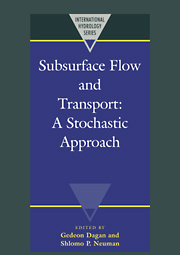Book contents
- Frontmatter
- Contents
- List of contributors
- Preface
- Acknowledgments
- I INTRODUCTION
- II SUBSURFACE CHARACTERIZATION AND PARAMETER ESTIMATION
- 1 Characterization of geological heterogeneity
- 2 Application of geostatistics in subsurface hydrology
- 3 Formulations and computational issues of the inversion of random fields
- III FLOW MODELING AND AQUIFER MANAGEMENT
- IV TRANSPORT IN HETEROGENEOUS AQUIFERS
- V FRACTURED ROCKS AND UNSATURATED SOILS
- VI A VIEW TO THE FUTURE
2 - Application of geostatistics in subsurface hydrology
Published online by Cambridge University Press: 04 December 2009
- Frontmatter
- Contents
- List of contributors
- Preface
- Acknowledgments
- I INTRODUCTION
- II SUBSURFACE CHARACTERIZATION AND PARAMETER ESTIMATION
- 1 Characterization of geological heterogeneity
- 2 Application of geostatistics in subsurface hydrology
- 3 Formulations and computational issues of the inversion of random fields
- III FLOW MODELING AND AQUIFER MANAGEMENT
- IV TRANSPORT IN HETEROGENEOUS AQUIFERS
- V FRACTURED ROCKS AND UNSATURATED SOILS
- VI A VIEW TO THE FUTURE
Summary
ABSTRACT Geostatistics is a theory that was developed in the 1960s to deal with the analysis and estimation of spatially distributed variables having a stochastic spatial structure. Initially it was applied to mining engineering, but later found interesting applications in many other fields such as subsurface hydrology A brief description of the geostatistical theory and a review of the most commonly applied geostatistical methods is first presented. Most relevant properties of the spatial correlation structure of some selected hydrogeological variables, including permeability, transmissivity and hydraulic head are described. Early applications of geostatistics in subsurface hydrology dealt with estimating hydrogeological variables at unsampled locations by means of point kriging and obtaining the corresponding map of estimation errors. Block kriging has been generally used to estimate block transmissivities in numerical flow models. With the increasing recognition of the paramount effects of spatial variability, geostatistical simulation gained more and more relevance. The particular properties of hydrogeological data (scarcity, variable support, measurement errors) compelled hydrogeologists to develop improved methods for estimating both drift and spatial covariance parameters. Geostatistical methods have been applied recently also to analyze hydrochemical and isotopic data. Another group of geostatistical applications in subsurface hydrology is related to optimum monitoring and observation network design.
INTRODUCTION
Geostatistics, a term coined by the French statistician G. Matheron of the Ecole des Mines Superieur de Paris in France, is a theory dealing with the estimation of regionalized variables. A regionalized variable (ReV) is any function z(x) that depends on the spatial location x and that exhibits a stochastic spatial structure.
Information
- Type
- Chapter
- Information
- Subsurface Flow and TransportA Stochastic Approach, pp. 44 - 61Publisher: Cambridge University PressPrint publication year: 1997
Accessibility standard: Unknown
Why this information is here
This section outlines the accessibility features of this content - including support for screen readers, full keyboard navigation and high-contrast display options. This may not be relevant for you.Accessibility Information
- 5
- Cited by
